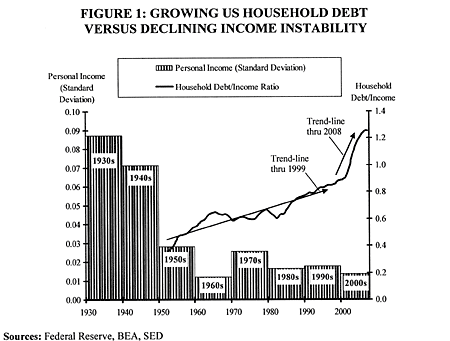
The credit contraction is still in its early stages and its ongoing implications are overwhelming.
As we have mentioned many times before, we are clients of the American Economist, Woody Brock of Strategic Economic Decisions, Inc. We get to receive his regular essays which have the power to uniquely identify the key issues. The first section of his recent August essay is headlined “It’s The Leverage, Stupid”. Early on he says,
“More tangibly, excess leverage creates a sequence of booms and busts that cost people their jobs and homes more often than would otherwise be the case. Yet there is no offsetting gain to society from this increased risk, since the long run growth of societal wealth must be equal to the growth rate of GDP, according to the Fundamental Theorem of Growth Theory. And GDP growth is not driven higher by excess leverage.”
In order to highlight the extreme nature of the credit situation and underline just how significant the unfinished credit contraction is for future asset values, we reproduce below a chart included in his essay.
This chart is specific to the US economy but we believe its essence and Woody’s remarks reflect equally on the problems in the UK and elsewhere in the developed world.
The grey-striped columns of each decade illustrate how, since the Second World War, incomes have become more stable than they were in the 1930s and 1940s. The reasons for this are firstly, that from the 1950s households mostly comprised two wage earners rather than pre-war, depending only on one. Secondly, employment in the manufacturing sector declined and employment in the service section increased. When the manufacturing sector is in recession, historically, huge numbers of workers were laid off. This vast improvement in income stability made it possible for banks to lend more generously and for consumers to be comfortable, borrowing more. The other section of the chart plots the Household Debt/Income Ratio. It was in an orderly uptrend until 2000 but then rocketed higher. It explains the potential viciousness of the credit contraction that is now underway to bring the Household/Debt/Income Ratio back in line.
We have observed a new, highly contagious, disease which we call “fall off the cliff syndrome”.
An obvious victim of “fall off the cliff syndrome” is the UK house market which is now, in our view, unpriceable due to insufficient transactions – only a year ago they said it was still rising at 10% per annum. It was reported this week that building societies have so slashed their mortgage lending that in June repayments outstripped new loans by almost £700 million. The Bank of England said that net withdrawals of mortgage lending by building societies is unprecedented; not even in the darkest days of the last property recession did net lending become negative.
The next likely victim of “fall off the cliff syndrome” will be retail spending. As we explained before, consumers are the plankton of the financial food chain and key to future economic growth, both in the US and the UK they are attributed to provide over 70% of GDP. Retailers say that they expect the toughest conditions for 30 years.
On Wednesday 13th August, the Bank of England formally confirmed that the economy required a painful adjustment, predicting it would grind to a halt for a year, with the possibility of one or two quarters of economic contraction (a recession). The economy is also a likely victim of the “fall off the cliff syndrome”.
Banks were very early victims of “fall off the cliff syndrome”. Their share prices have collapsed, their balance sheets have been decimated and their reputations justly damaged
The key issue is that the credit contraction is still in its early stages and its ongoing implications are overwhelming. There will be periodic favourable swings of better sentiment. Of late, the banking sector has enjoyed a significant rise, although from the chart you can see that it is no more than a modest rally in a vicious bear market – a selling opportunity, not a buying opportunity.
Corporate earnings will continue to disappoint. From a recent Merrill Lynch survey of fund managers, 83% said that the S&P earnings estimates for the next twelve months are too high. Prior to that, Thomson Reuters said that S&P 500 company earnings were on track for a possible 22% decline in the second quarter, twice the level expected at the start of June this year.
Yet again, Lowry’s Selling Pressure Index recently hit a new multi-year high. In their 75-year history, no meaningful bottom of the US stock market has ever occurred within a month of a new selling pressure index high. Long term investors are selling into any rally.
Over the coming period, the big signals to watch will be retail sales and unemployment – expect the first to dramatically fall and the second to rise faster.
It’s not all bad news because investments inversely correlated to the stock market are doing well. The SocGen Global Index Bear Accelerator, which is a significant part of clients’ portfolios, has generated valuable gains and these are likely to become much bigger during the rest of this year.
Japan remains the one potential primary bull market in the developed world. We remain confident that the low set in 2003 was the end of the thirteen year Japanese primary bear market. What is taking place now should lead to a buying opportunity this year or next.
• By John Robson & Andrew Selsby at Full Circle Asset Management, as published in the threesixty Newsletter